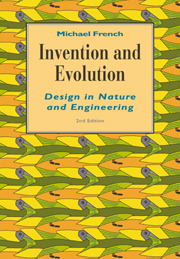Book contents
- Frontmatter
- Contents
- Preface to the second edition
- Preface to the first edition
- Acknowledgements
- 1 The designed world
- 2 Energy
- 3 Materials
- 4 Mechanism
- 5 Structures
- 6 Systems
- 7 The practice, principles and philosophy of design
- 8 Economy, form and beauty
- 9 Production, reproduction, evolution and design
- 10 Designing and inventing
- 11 Some case studies
- Questions
- Answers
- Suggestions for further reading
- Index
11 - Some case studies
Published online by Cambridge University Press: 06 January 2010
- Frontmatter
- Contents
- Preface to the second edition
- Preface to the first edition
- Acknowledgements
- 1 The designed world
- 2 Energy
- 3 Materials
- 4 Mechanism
- 5 Structures
- 6 Systems
- 7 The practice, principles and philosophy of design
- 8 Economy, form and beauty
- 9 Production, reproduction, evolution and design
- 10 Designing and inventing
- 11 Some case studies
- Questions
- Answers
- Suggestions for further reading
- Index
Summary
Introduction
It may be a good way to illustrate the absorbing intellectual problems presented by engineering design to recount some of the more interesting examples that have come my way, and so I have added this new chapter to the second edition. Several themes emerge, for instance, that there is nothing new under the sun and that most, if not all, invention reduces to the adapation of old ideas to new circumstances or new functions. Another is that contemplating a problem in a ruminative frame of mind may lead to a feeling that there must be a better way than those so far thought of. Known solutions sometimes have a hint of the digging of holes simply to fill them up again, which may be a pointer to such a better way, if we can only spot what it is.
The spotting of a case of digging a hole to fill it up is one example of the important insights which mark the progress of much design. Often it is only after a lot of apparently fruitless work that there suddenly dawns a great light, and we know where we are going. There is then rapid progress for a while, but alas, there are often further struggles before we achieve a satisfactory conclusion, if indeed we ever do.
End-balancing of gas turbines
Figure 11.1 shows, very diagrammatically, the compressor and turbine of a simple gas turbine.
- Type
- Chapter
- Information
- Invention and EvolutionDesign in Nature and Engineering, pp. 322 - 349Publisher: Cambridge University PressPrint publication year: 1994

